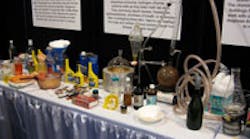The mock lab included marijuana grow and cannabis oil extraction operations as well as synthesis labs, such as methamphetamine (meth), ecstasy and Rohypnol. The display featured videos, photographs and other health and safety information relevant to personnel who respond to emergency situations at these illicit drug labs. The lab demonstrated that first responders must be thoroughly and specifically trained to recognize signs that a structure may contain an illegal drug operation in order to keep themselves and the public safe.
Colorado Attorney General John Suthers was on site at AIHce to discuss the threat clandestine drug labs pose to first responders and the public.
“Although great strides have been made in reducing the number of methamphetamine labs in Colorado, the dangers these labs pose still exist, and I applaud the work of industrial hygienists, law enforcement officers, firefighters and the National Alliance of Drug Endangered Children in continuing to attack the problem and for providing for the safety and well-being of children caught up in these labs,” said Suthers.
Industrial hygienists explained that these clandestine drug labs increase the risk of electrocution, entrapment and exposure to corrosive and toxic chemicals as first responders arrive on the scene to do their jobs. In addition, the presence of defensive measures such as booby traps, weapons and criminals at these clandestine labs also pose an extreme risk to authorities and the public.
Marijuana Grow Operations
While the public appears to more readily embrace the fact that meth labs pose hazards, threats from marijuana grow operations seem less obvious. This lead experts at AIHce to refer to the recent increase in marijuana grow operations as “the dark horse” or “the sleeping giant.”
“Last year, Colorado had a steep increase in marijuana grow operations,” Suthers said during a press conference at AIHce. In fact, the North Metro Drug Task Force in Colorado has conducted 65 investigations of marijuana grow operations that involved the confiscation of nearly 5,000 plants so far this year. Overall, the number of marijuana grow operations seized in the United States and Canada has increased at an alarming rate during the past 5 years.
The hazards linked to indoor, large-scale marijuana grow operations include high carbon monoxide levels; severe mold, exposure to chemicals, pesticides and fertilizer; and more. To cultivate the marijuana, significant illegal modifications are made to the homes or structures used to house marijuana operations: holes for ventilation; water supply; electricity for lighting and appliances; and tampering with organic, fuel-fired furnaces and hot water heaters to provide heat, humidity and carbon dioxide.
“The public deserves to know what hazards these operations pose,” Suthers stressed.
Meth Labs
Meth can be made almost anywhere, and commercial buildings, houses, apartments, hotel rooms, trailers, barns, vans and storage units are just some of the structures used for labs. Although many are located in rural areas for privacy, meth labs can be found in urban and suburban areas.
The danger of fire and explosions is always present in meth lab operations, and even after they are dismantled, meth labs leave a toxic trail of chemical dust and vapors that can seep into adjacent spaces, including neighboring homes, apartments and hotel rooms. Walls, floors, toys, furniture, ventilation systems, plumbing fixtures, septic systems and surrounding soil can be contaminated and may require professional decontamination.
Among those at risk of exposure are real estate agents, landlords, property managers, prospective renters, homebuyers, garbage collectors, utility workers, plumbers, social service agents and first responders. Children living in the vicinity of a meth lab can be put at risk. In fact, thousands of clandestine seizures each year involve children. Visitors or neighbors can be harmed by the poisonous vapors that vent from meth labs or from the toxic “cooking” debris that is sometimes buried outside or flushed into a septic system.
Respiratory problems, eye irritation, headaches, dizziness and nausea are some of the symptoms people may experience if they are exposed to contamination from a former meth lab site.
“Industrial hygienists are the guardians of health and safety in the workplace and among the public,” said AIHA President-elect Michael Brandt, MS, MPH, DrPH, CIH. “Not only does this mock lab dramatically illustrate and address the hazards posed to first responders and the public, it also educates about how to safeguard themselves by properly assessing health and safety risks from these labs.”


